Joy Neal Kidney's Blog, page 4
August 4, 2025
This beautiful book, like a meadowlark’s song floating across the Iowa plains, lingers—melancholic, inspiring, and completely human
In Meadowlark Songs: A Motherline Legacy, Joy Neal Kidney serves as both a historian and a bard for her own bloodline, following the sinewy thread of maternal inheritance through seven generations of Iowa women. With surprising tenderness and an eye for the softly important moments of everyday life, she curates a lyrical history that is part memoir, part elegy, and part love letter to those who came before.
This isn’t a book about major events or political movements. Rather, it is a deep, resonant dive into the personal geography of family—cooking fires and quilt stitches, Sunday feasts and funeral hymns, meadowlarks’ songs and the weight of antique dinnerware. via the lives of Jane, Lucy, Emilia, Laura, Leora, Doris, and finally Joy herself, we see how strength, faith, sadness, and perseverance are passed down not only via mitochondrial DNA but also through gesture, memory, and example.
The themes of faith, adversity, and female agency recur throughout the story. This is especially evident in the lives of women like Leora Goff Wilson, who kept her family afloat during two world wars and the Great Depression, and Doris Neal, a lady shaped by hard times, sorrow, and resilience. These tales show how character is formed in the crucible of history, how hope is nurtured during difficult times, and how women pulled families together through sheer willpower and practical magic.
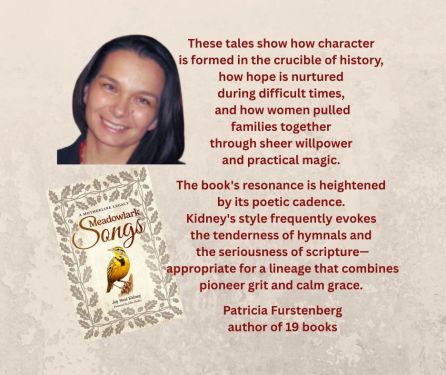
The book’s resonance is heightened by its poetic cadence. Kidney’s style frequently evokes the tenderness of hymnals and the seriousness of scripture—appropriate for a lineage that combines pioneer grit and calm grace. Her chapter titles sound like folk songs—”Meadowlarks and Prairie Roses,” “Faith,” “Eggs and Dandelion Greens,” “That Awful Feeling of Grief”—and the entire work is filled with the music of recollection.
Though based on a single family’s tale, this book conveys a universal truth: we are all the product of those who came before us, formed by their choices, guided by their ideals, and frequently inspired by the quiet courage of their lives.
Readers of family memoirs, American history buffs with a concentration on pioneer and Depression-era living, genealogists, women’s history lovers, and anybody who has ever turned the yellowing pages of an old photo book and wondered what happened to the people in those sepia photographs.
This beautiful book, like a meadowlark’s song floating across the Iowa plains, lingers—melancholic, inspiring, and completely human.
Patricia Furstenberg is an internationally published author of 19 books, celebrated for her evocative blend of historical fiction, folklore, and poetic storytelling. She lives between worlds — Romania and South Africa, folklore and fact, medicine and literature — crafting stories that explore human tenacity, historical nuance, and the enduring power of compassion. Whether writing for adults or children, her books invite readers to pause, reflect, and rediscover the extraordinary within the ordinary.
Patricia’s Author Page on BookBub
August 2, 2025
Good news: Relief, blessings and hope
Catching up. . . .
Monday – Inflectra biologic IV infusion, offering hope (along with side effects)
Tuesday – Still foggy from Benadryl given (IV) before the infusion, but okay
Wednesday – Dr. Flores called to see how I’m doing. She expected the Inflectra to be at work already, which is why she chose it over another biologic. A lthough I was skeptical that the drug would work so soon, it was an amazingly quiet day. After everything that hadn’t worked and/or made things worse, this seemed like such a wonder.
Thursday – Exhausted but “miserable middle” still calm. Miracle.
Friday – Ran into Dr. Flores in Mercy’s lobby as I headed for another CT scan. She’s also encouraged by how well I’m doing. She added another med (more side effects) to keep me from rejecting the infusion.
Bonus: Lunch after the CT scan at the Machine Shed. If you can enjoy your food, thank God every single day. How awesome it is not to have to worry about what could happen if I eat solid food. As we were leaving, we noticed half a dozen autographed copies of Meadowlark Songs prominently displayed in the gift area. (Wish I’d taken a photo.)
One of the themes in Meadowlark Songs is great losses. Mine include loss of health, starting a couple of dozen years ago with fibromyalgia. This year that loss broadened and deepened with the onset of Crohn’s.

Another theme in the book is faith in God and thankfulness. Both have also broadened and deepened during these physically miserable months. The Lord has been with me through it all, offering hope for this world and the next.
Another blessing: Amazon orders for July will pay for my next ad in Iowa History Journal.
No needles until August 11, when the next infusion is scheduled.
I’m so grateful for your prayers and well-wishes on this new journey.
July 31, 2025
Clabe Wilson’s Sauerkraut
The spring of 1938 Leora bought day-old Leghorn chicks from Pop Scott’s, for fried chicken and for eggs to eat and sell. The Wilson family planted lettuce, spinach, onions, green beans, bushels of tomatoes and the nicest cabbage they’d ever raised. Leora poured suds water from the family wash over the cabbage plants to ward off worms. She sold some of the cabbage to a local grocer and Clabe made sauerkraut in ten-gallon stone jars.
To make kraut, Leora chopped the cabbage and Clabe added kosher salt to it in large crocks. He cut boards to fit into the top of the crocks, the weighted the boards with bricks to begin the process, keeping the cabbage under the brine as it began to form.
Autumn is the best time to make sauerkraut since late season varieties of cabbage contain more natural sugars that help with fermentation.
—–
I didn’t find a recipe for sauerkraut among Grandma Leora’s keepsakes. Perhaps Clabe just made it from memory, but here is a simple recipe.

In Leora’s little Memorandum book, dated March 31st, 1915, she wrote and pasted recipes. One is for cabbage salad dressing.
Cabbage Salad DressingOne egg
Butter size of an egg
One teaspoon of cornstarch
Two tablespoons of sugar
One-half cup of sweet milk
Boil all this and then pour over chopped cabbage.
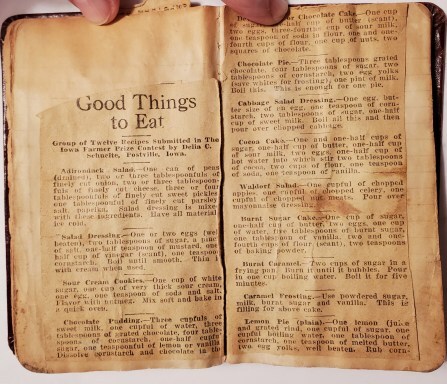
From Leora’s Dexter Stories.
July 28, 2025
So far, nothing has eased the misery

July 14, 2025
Carry on, friend. Keep writing.
Reviewed in the United States on May 3, 2025
Format: KindleVerified Purchase“Oh Joy – what a journey I have just taken with Leora, Clabe, the twins, the girls, the boys, the farm, the old John Deere….I can see Leora’s chickens and smell Clabe’s pipe in my dreams.
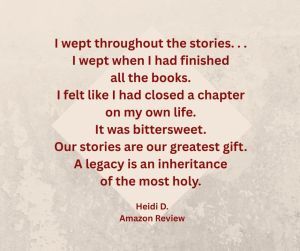
“I wept throughout the stories. And then, I wept when I had finished all the books. I felt like I had closed a chapter on my own life. It was bittersweet. Our stories are our greatest gift. A legacy is an inheritance of the most holy. Thank you for the painstaking research, the documentation and finally for the closure the boys deserved and the family (and I) needed.
“Thank you for sharing the strength of the American spirit, especially demonstrated by the Wilsons and their mammoth heartbreaking sacrifice in the name of our country. I was especially impressed by the utter generosity of all the children to their parents. Whether it be financial or just working to keep the family afloat in good and bad times, the children were obviously raised with generous hearts.
“Carry on, friend. Keep writing. I would love to read more and more about the mid-west and the backbone of the US. Thank you again and again.
“When I retire, soon, I want to visit the graves. I want to see Dexter, Perry, all of Guthrie County[,] the land Leora and Clabe finally owned. I feel like I know all of them and it has been my honor to learn about them and share in your story. What a gift! Thank you.”
What an encouraging review, Heidi D. Bless you for this!
July 12, 2025
Not ready for the woodpile yet – guest post by Shane Goodman

This piece by Shane Goodman, Editor and Publisher of the [Guthrie] Times Vedette digital newsletter, stuck with me after I’d read it. The compelling similarity to the human body, experiences, and memories as we age. Shane gave me permission to share it:
From the Publisher: Not ready for the woodpile yet
I inherited some old Adirondack chairs a few years ago. At the time, I reasoned that with a light sanding and a new coat of paint, these could be nice chairs. When my light sanding peeled off sheets of paint, I knew I was in for more work than I had planned. I persisted, though, using a power washer to take off the large stuff and an orbital sander to smooth it out. After two coats of oil-based primer, two coats of top paint, and many hours, my wife asked why I didn’t just buy new chairs. Fair question.
The answer was that this became a challenge I had to conquer. The amount of time or money I was putting into the chairs quickly became irrelevant. I simply had to win. Something was pushing me to save these chairs.
While power-washing, sanding, priming and painting, I couldn’t help but think about what these old chairs had been through, and I smiled as I thought how similar they are to the human body.
Each layer of paint represents memories for someone. These are the experiences the prior owners had, much like the clothes we choose to wear on our bodies. Sometimes old and worn. Sometimes faded. Sometimes needing repaired. Sometimes needing replaced. But we also sometimes hang on to them, often by needle and thread or with a new accessory to make the old appear new again. Even so, each layer — each color — represents a specific stage of life.
Underneath those layers of paint, I found a few damaged boards that needed repair — broken bones, you might call them. Despite the fix, they are not quite the same. The repaired pieces don’t blend in with the others, but they do keep the old chairs usable, at least for a while.
Securing these boards were a bunch of rusty screws — the joints of the chairs. At first, they were shiny, new and sharp, made to hold the bones together. Over time, they weakened, became discolored and even broke off. So, in a surgical DIY effort, I took a few of the worst ones out, and I screwed in shiny, new, sharp ones again.
While putting in the new screws, I realized that some of the core wood was soft and rotten, no longer able to do what it was intended to do. The shiny, new, sharp screws couldn’t hold that mush together anymore. Repair was no longer an option. These vital boards — the organs of my chairs — needed replaced immediately.
I did the work to these chairs a few years ago, and I am proud to say they are still standing today. Sure, the paint is peeling in spots again, and a few more repairs are needed, but they are usable. My wife says they need to be discarded, maybe even set aflame. I am not ready to throw them in the woodpile just yet. Like most of us, with a little TLC, they have a few more good years left in them.
Have a terrific Tuesday [July 8, 2025], and thanks for reading.
Shane Goodman
Editor and Publisher
Times Vedette digital newsletter
shane@gctimesnews.com
641-332-2707
Shane Goodman is also the publisher of Cityview, “Central Iowa’s premiere monthly magazine,” according to John Busbee of the Culture Buzz. President and Publisher of Big Green Umbrella Media.
[image error]
Johnston office8101 Birchwood Court, Suite DBirchwood Crossings Business ParkJohnston, Iowa 50131515-953-4822, ext. 305Guthrie County office104 Industrial RoadGuthrie Center, Iowa 50115641-332-2707www.biggreenumbrellamedia.comJuly 10, 2025
Paper Dolls through the Generations
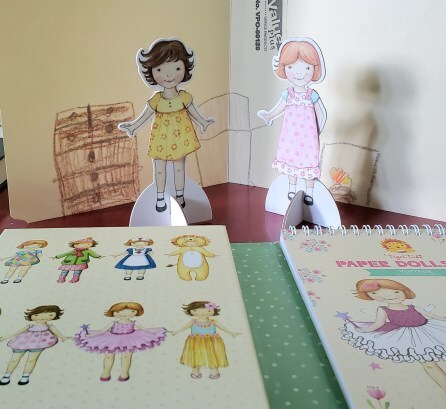
sent a Dolly Dingle paper doll with clothes to change,
along with a story poem about Dolly.
When I was a girl, my sister and I cut out ladies
from the Sears catalogue, then chose catalogue clothes
for them to wear. Gloria’s doll was named Luanne.
When granddaughter Kate was here we played paper dolls
with a kit gifted by friend Lynne, who has lots of granddaughters.
The two cardboard girls have stands so they can model
what we cut out for them–dresses, rompers, costumes.
Kate drew a backdrop for them from a file folder,
then cast them in a video skit of knock-knock jokes,
complete with her mother’s laugh track in the background.
July 8, 2025
Dolly Dingle

Little Doris Wilson’s aunt Georgia Goff sent her this Dolly Dingle paper doll, along with a hand-written poem.
Des Moines, Ia.Mch. 3, 1920 (or 1921)
1322 - 40 St.
Doris' Dolly Dingle
I
Please accept Dolly Dingle
Whom you may spank
With her little shingle
If she should show her spunk.
II
Her dresses too I give to you,
pretty hats, & playthings.
Yes, she has a cat.
III
I must explain
So you can change
Dresses on time
Lest she whine.
IV
She wears green on Sun.
And plays with her cat
Would you believe it?
Just look at that.
V
A pink little dress
For morning wear.
A sack of cookies?
Why! that's her fare!
VI
She plays with her doll
In the afternoon.
Listen! and hear
The bye-bye tune.
VII
Her Sailor Suit for any day
When she wants to look
At her story book,
Or play in the sand
Oh! isn't that grand?
VIII
Ah! her party dress
Isn't it dainty?
(I'm afraid she looks a little bit painty.)
Why, she wears that
When she dances with Jess.
To Doris - From Aunt Georgina
The Dolly Dingle paper dolls were designed by Grace Drayton, who also illustrated children’s books, fashion pages, and magazine covers. The paper dolls appeared in the women’s magazine Pictorial Review. Considered as one of the first and most successful American female cartoonists, Grace Drayton created the Campbell Soup Kids.
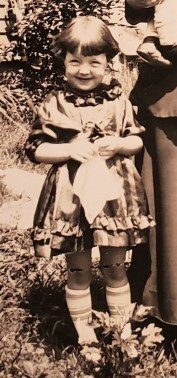
Doris Laurayne Wilson, August 1921, Stuart, Iowa
July 3, 2025
Claiborne Junior Wilson born 100 Years Ago, Dallas County, Iowa
Grandmother Goff’s low voice early in the morning meant a new baby. Such an exciting time! Claiborne Junior Wilson was born July 6, 1925, at the Hemphill place, the first Wilson born in Dallas County. It was so hot upstairs with no fans so they slept downstairs.
The Ringling Brothers circus came to Des Moines ten days later. Grandmother and Leora, mother of the Wilson kids, stayed home with baby Junior, two-year-old Danny, and the five-year-old twins, who’d be too hard to keep track of in a crowd.
The circus-goers were up before daybreak. The kids headed outside even before the roosters crowed. Leora fried chicken for their dinner, to enjoy with buttered bread. They drove the Model T to Des Moines. Once inside the circus area, Clabe told Doris to hang onto his finger so she wouldn’t get lost.
They watched the circus animals in their cages before the big show started. Grandfather bought pop for everyone. With seats near the middle of the tent, they could watch the acts in all three rings. Back home, the boys could hardly wait to tell about the fat clown, who opened a door in the front of him and a little dog jumped in and came out at the back.
And when they got home, they had a new grandmother. Leora had given her a new modern haircut.
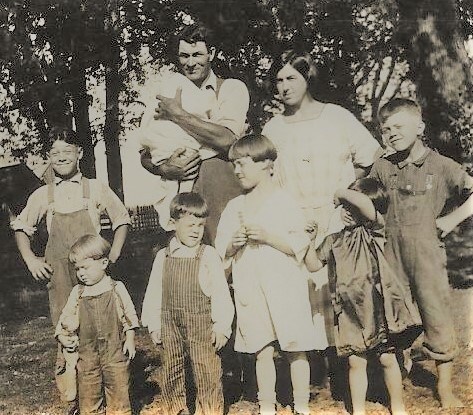 Back: Delbert, Clabe holding Junior, Leora, Donald. Front: Danny, Dale, Doris (her 7th birthday), Darlene. Near Dexter, August 30, 1925
Back: Delbert, Clabe holding Junior, Leora, Donald. Front: Danny, Dale, Doris (her 7th birthday), Darlene. Near Dexter, August 30, 1925Leora’s Early Years: Guthrie County Roots
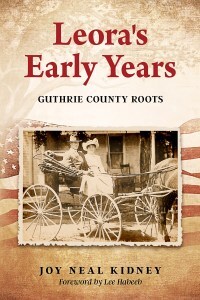
How are we doin’?
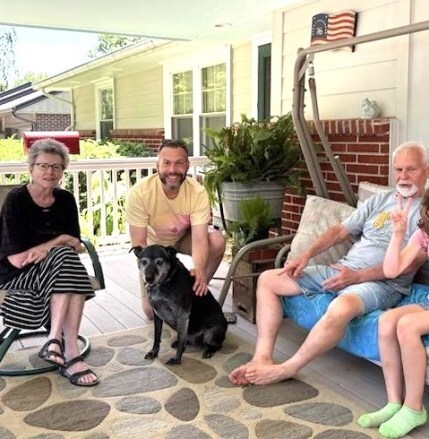 A recent photo taken by daughter-in-law Renee: Joy, Dan with extra needy rescue dog Luna, Guy, and Kate (her parents don’t want her darling little face on social media). Yes, that’s an old wash tub holding this year’s fern.
A recent photo taken by daughter-in-law Renee: Joy, Dan with extra needy rescue dog Luna, Guy, and Kate (her parents don’t want her darling little face on social media). Yes, that’s an old wash tub holding this year’s fern.My Favorite Guy just had a checkup with his neurologist. There’s no blood test for Parkinson’s Disease, no CT scan, no MRI. It’s mostly Dr. Kahout’s experience, observations, and intuition about how Guy is doing. This is a season of losses for us both. Guy can no longer take his extra walk (without his slower spouse), hasn’t gardened for the first year ever, and wears out more quickly.
He learned during his last checkup at the blood+cancer center that now he’s a little anemic, so they adjusted his chemo meds. That explained his extra exhaustion.
Dr. Kohout also asked how I’m doing. I’ve recently been diagnosed for Crohn’s but the first medicine didn’t work, so I started on prednisone this week. It looks like we’ll be adding trips to an infusion center when that gets okayed and set up.
But even with the unwellnesses we’re dealing with, we’re both thankful we didn’t develop them earlier in life. And we’re in a “good place,” with a comfortable home to feel crummy in, each other, and appliances that work (thanks Brian). If/when I get to the place where I can have meals out again, we’ll be able to enjoy breakfast or lunch.
God is weaning us from earthy delights, turning our attention toward the other side where Christ has prepared a place for us. A place without diseases and steroids and IV infusions.
On this side of heaven, Meadowlark Songs was published in the middle of my quest to find out what was causing my miserable middle.
I’ve not had the energy to enjoy radio interviews, which are my favorites. The new book has only a few reviews on Amazon, Goodreads, and BookBub. I’m so grateful for two faithful bloggers who have featured Meadowlark Songs on their websites.
Meanwhile, would you believe that I’m praying for enough energy to pursue the next book? Or two? Oh, wait. I’m supposed to be downsizing.



